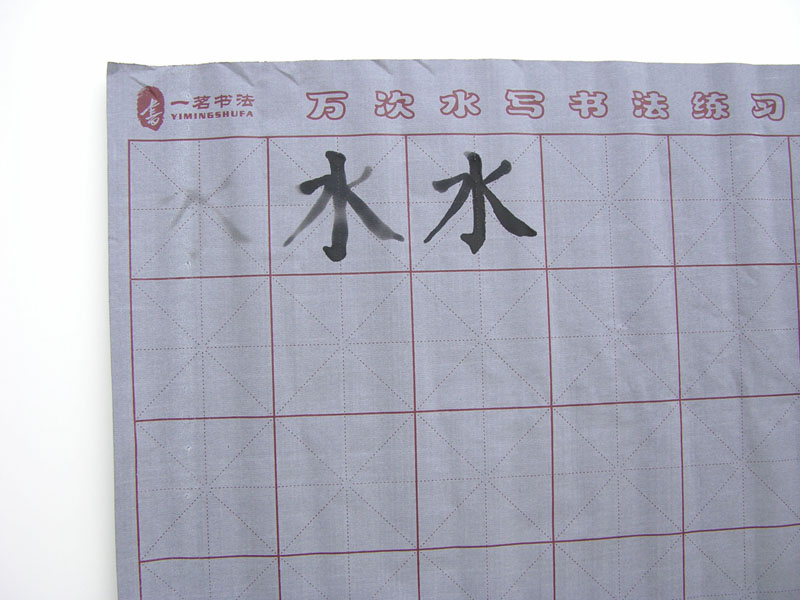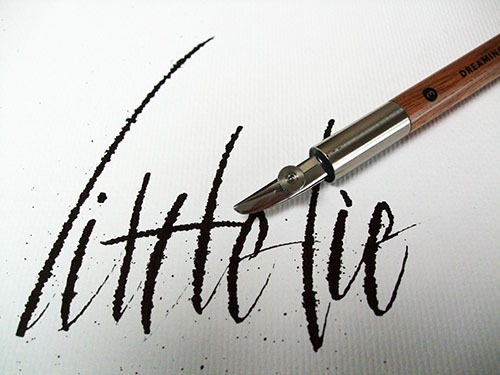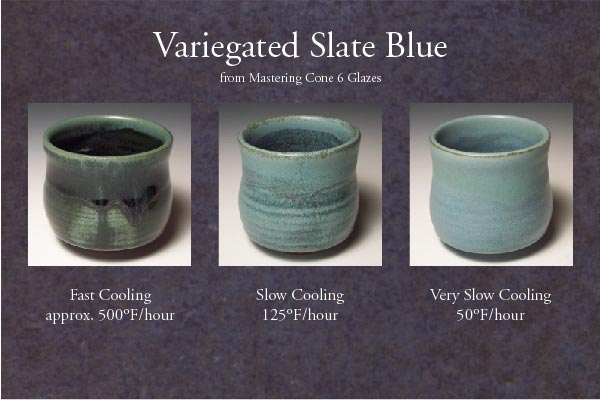
PeterH
-
Posts
1,496 -
Joined
-
Last visited
Content Type
Profiles
Forums
Gallery
Posts posted by PeterH
-
-
24 minutes ago, Bill Kielb said:
Can you post the schedule, in this graph for the last hour or so it is firing on the order on 50 Degrees f per hour which seems be a bit odd for a cone fire schedule.

Isn't that 120f in the last hour and 100f in the preceding 58m?
(1948-1828)f in (16:18-15:18)
(1828-1728)f in (15:18-14:20) -
Thin pickings ... but it looks like she sprayed kaolin slip onto really dry sanded clay.
From https://www.mi.sanu.ac.rs/vismath/friedman1/index.html
I build big forms, the clay will dry slowly and not collapse. When the form is ready and the clay is dry, I sand away at the surface and then spray it with a slurry of kaolin. The pieces are finally fired in stoneware temperature, about 1250
From https://www.callancontemporary.com/press/non-present-presence-eva-hild-s-evocative-sculptures-fill-space-with-meaning-and-poeticism-art-new-orleans
Each work is monochromatic, either in pristine white or rich, chocolate black, and results from a four- to six-month-long process. Hild shapes stoneware clay into coils, allowing plenty of drying time, then fastidiously sands and sprays them with kaolin coating to impart a preternaturally matte finish. Finally, she fires them at 1,250 degrees Fahrenheit, ending their long genesis and beginning their new journeys as objects d’art. -
Wiring diagrams
Paragon site
https://eadn-wc04-7751283.nxedge.io/wp-content/uploads/A66WD.pdf
Clearer image and firing schedules
https://ltt.arizona.edu/sites/ltt.lab.arizona.edu/files/MED Paragon Kiln Wiring Diagrams and Parts ID.pdfThe diagram emphasises Neil's points on the need for a 4-wire supply.
The B in A-66B indicates a stainless steel jacket... can you also post a picture of the 230v shown on the front, it may be on something like a controller/kiln-sitter mounted on the kiln itself.

-
TNF-82 spec https://shop.clay-planet.com/Paragon-TNF-82.aspx
Wiring for TNF-82 https://eadn-wc04-7751283.nxedge.io/wp-content/uploads/wtnf82.pdfI find it hard to see how it's only pulling 12 to 15A at full power. [With 240V measured across the elements and all elements conducting/glowing.]

R=1/2*(10+6)=8
V/R=240/8=30 -
Possibly relevant:
Outdoor Weather Resistant Ceramics
https://digitalfire.com/article/outdoor+weather+resistant+ceramicsThis thread, especially
-
17 hours ago, Hulk said:
I'm seeing Krueger carries a replacement, does the image match?
Shimpo RK-2 Parts – FWD/REV Switch Knob (RK Common) – Krueger Pottery SupplySadly that looks like the knob, the switch appears to be sold out
https://kruegerpottery.com/collections/rk-2-parts/products/tanac006232-rk2
It's also discontinued here https://www2.ceramics.nidec-shimpo.com/parts-list/I found no immediate hits for the part-no SRH623-2
Wiring instructions here https://www2.ceramics.nidec-shimpo.com/wp-content/uploads/2019/06/RK-2-WIRING-Troubleshooting-Manual.pdf
I would guess that the switch gives straight-through, crossed and no connections, although I've no idea which pin is which (or what this type of switch is called). Maybe you could find an "equivalent" switch that would physically fit?
A UK search for "changeover switch" gives some ideas.
A search for "shrimpo crossover switch" gives several hits, including
https://www.theceramicshop.com/product/27976/fwd-rev-switch-vl-whisper/
This is a replacement forward and reverse switch for the Shimpo VL Whisper and RK Whisper pottery wheels.
This item is the switch only, but for the switch assembly click here. Unsure if this is equivalent (or even 3-way) let alone a direct replacement.
Unsure if this is equivalent (or even 3-way) let alone a direct replacement.
Good hunting!
-
14 hours ago, Jeff Longtin said:
Not really sure why it happened but I do try to keep beverages away from molds as a result.
Could the fact that "dried" coffee is deliquescent have anything to to with it? [Tending to absorb moisture from the air and dissolve in it.]
Do molds stored where they are permanently damp have similar problems? Obviously multiple wet/dry cycles are not a problem.
-
3 hours ago, Cecil said:
Hi, have the same kiln in South Africa. What I can't figure out is how to use the knob next to the two indicator lights. What does it do??
A photo would help. But here is a manual for the LT-K & LT-3K kiln sitters.
http://www.fireright.com/docs/kilnsitter/lt3andk.pdf
-
Thank you for your patience.
Looking at the figure in the as-cast orientation:

... and assuming that the dotted line marks the intended parting-line, and is where the clay was positioned before casting.
The current position of the plaster suggests that:
- either the figure has moved away from the plaster after casting (perhaps as the embedding clay was pulled away)
- or the embedding clay moved to enclose more of the figure during the casting (difficult to imagine, especially given the cleanly cast edge)Can you pull the figure out of the plaster and look at the cast. Is the cast "clean"? How far up the figure would the cast go?
Can you push the figure back into the cast. How far does it go in?
Obviously any undercuts will hinder the movement of the figure relative to the plaster.
-
I'm having trouble visualising your process.
1) Can you reference one of the tutorials you are basing your process on?
2) You print a hollow figure then "As a filler I used stoneware clay and fill exactly half the object". As I assume you are trying to take a mould of the outside of the figure why not just entirely fill it with clay? (Obviously I'm missing something here.)
3) You seem to be trying to take a casting of the lower side of the figure which is presumably resting on plywood. I'm far more familiar with first taking a casting of the upper half of the figure, with the lower half embedded in clay. As shown in :
Mold Making and Plaster Mixing 101
http://www.davidwbolton.com/uploads/5/5/1/4/55145091/moldmaking_and_plaster.pdf
Then flipping and casting the other side

-
Some eye-candy and tips on slip-cast multi-layer work - but for bone china rather than parian ware.
Multi-Colored Casting in Tempting Transparency
https://ceramicartsnetwork.org/pottery-making-illustrated/pottery-making-illustrated-article/Tempting-Transparency#Some examples of Sasha Wardell's work at http://www.strathearn-gallery.com/artists/435/sasha--wardell
PS Can you use setters with parian ware? It might be useful if you could.
-
Any relevance?
Lithium Carbonate 200CND/Kg (shipping $12.50?)
https://psh.ca/products/lithium-carbonate-1 -
2 hours ago, LinR said:
Greenbarn is where the group get their materials. I'll check again with the glaze chair. $400 was what I was told. Lin
This Greenbarn?
-
2 hours ago, High Bridge Pottery said:
Yes looks like I can source it there, thanks for the tip Callie. Not so sure about pool supplies in the UK Bill
 I am sure there's commercial suppliers but not many people have their own.
I am sure there's commercial suppliers but not many people have their own.
It might be worth trying excess hot vinegar first.
Mechanism and kinetics of wollastonite fibre dissolution in the aqueous solution of acetic acid
https://www.sciencedirect.com/science/article/abs/pii/S0032591010005267?via%3Dihub
The dissolution of fibrous wollastonite (CaSiO3) in the aqueous solution of acetic acid (3 mol dm− 3) was investigated in the temperature interval from 25 to 50 °C using mixed batch-type reactor.
I'm a bit uncertain, but I think that 3 mol dm− 3 is about 18% vinegar. The pickling vinegar I use for descaling my kettle is 6%, so it would be weaker than that used in the paper, but might still be strong enough to dissolve your crystals (if they are derived from Wollastonite). Perhaps worth trying before you buy the HCl.PS You might be wise to check my workings.
Molar mass of acetic acid ~60g https://en.wikipedia.org/wiki/Acetic_acid
1dm = 10cm. 1 dm 3 = 1000ml = 1 litre
So 3 mol dm− 3 = 3*60g/l = 180g/1000g = 0.18 = 18% -
A few thoughts on your crystals
- As you cannot dissolve them in hot water this might indicate that they aren't boron-based.
- If you have dilute hydrochloric acid it will dissolve most calcium salts, including the silicate
... see A in http://www.pharmacopeia.cn/v29240/usp29nf24s0_m12120.htmlIf you find a way of reproducibly creating the crystals it might be interesting to try:
- Using a different deflocculant (Darvan?), which will probably change the pH of the slip which might change things.
- Seeing if a small addition of sugar to the fresh slip influences the growth of the crystals [*]
[*] Adding sugar would probably be very bad for the moulds, but just might form an interesting experiment. I mention it because sugar has a significant effect on the settling time of cement, apparently by its surface action on things like Wollastonite.


-
Just to mention the discussion of unwanted crystal growth in http://ceramicstoday.glazy.org/articles/flambe_magic.html
... it also makes me wonder if there could be a "pumping" action if the liquid is repeatedly warmed and cooled.
-
49 minutes ago, PeterH said:
... and even if it's only "yellow" dextrin it would probably be a better starting point than cornstarch for your own processing.
-
Dextrin is readily available from small-scale pyrotechnic ingredient suppliers (if you can find them). My limited experience of these (looking for pottery ingredients) suggests that they are fairly cheap and very technically savvy.
But I've no real idea how to assess the "quality" of the dextrin they supply (other than it's suitability as a firework ingredient).
US example https://www.fireworkscookbook.com/product/dextrin/
I suppose that you could try asking them for advice.
-
>If anyone is aware of a small quantity source for the darker, more deeply pyrolyzed starch sizing/adhesive called "British gum" please let me know.
May be of relevance.
Pyrotechnics data for your hobby: Dextrin
https://pyrodata.com/chemicals/Dextrin
Sources:
Dextrin is easily prepared from starch. Potato and cornstarch will both work fine. The starch is spread out on a sheet in a layer about 1 cm thick and placed in the oven. The oven is then heated to 220°C(400°F) for several hours. The dextrin will turn slightly yellowish brown. One way to check if all the starch has been converted is to dissolve a small sample in boiling hot water and add a drop of KI3 solution (Lugol's iodine solution). A blue colour indicates presence of starch, which means the conversion hasn't completed yet. KI3 solution is conveniently prepared by dissolving a crystal of elemental iodine in a potassium iodide solution.
The complete removal of starch could be important in your application, so I would try the starch-iodine test.PS
Dextrin and Making Dextrin
http://www.wichitabuggywhip.com/fireworks/dextrin.html
-
14 hours ago, creegal said:
Why not get a thinner Chinese ink painting brush...it will achieve all different kinds of line thickness depending on your pressure as well as how much product you load onto brush.
If you are trying different brushes & handling techniques there is a Chinese calligraphy practice paper/cloth that you can draw on with a water filled brush. When wet it gives a dark image which slowly fades as it dries. Often called magic-paper/cloth. Sometimes it has guide-lines for calligraphy, but plain sheets are also available.

PS another sort of specialised brush

-
More types of ruling pin nibs than I'd thought (my only experience is a little technical drawing 60 odd years ago).
All About Ruling Pens https://sarahtypes.com/all-about-ruling-pens/https://www.johnnealbooks.com/prod_detail_list/ruling-pen-basics

-
12 hours ago, Ben xyz said:
No experience, but might that have been done with a ruling pen? Although these are often used to make very uniform "ruled" lines I believe that shifting the angle of use can produce varying line widths. This example seems to have a similar blotch-iness in the thicker lines in your example.

Are You Using Your Ruling Pen to its Full Potential?
https://garnerwildlifeart.wordpress.com/2021/05/28/what-is-a-ruling-pen/
- Rae Reich and Bill Kielb
-
 2
2
-
Just eye candy: glazes where slow cooling can have a dramatic effect.
From Super Cool! Slow Cooling in an Electric Kiln
https://ceramicartsnetwork.org/daily/article/Super-Cool-Slow-Cooling-in-an-Electric-Kiln

...and

- nathanhinshaw, Hulk and Rae Reich
-
 3
3
-
3 hours ago, Babs said:
I think there was a post on that relatively recently.
Might have been this one, where the choice of terminology seemed to be a hindrance rather than a help.
I'll freely admit that I'm not sure what temper means, and I'm pretty sure that it means different things to different people.
One meaning is:
Temper is non-plastic material that is added to clay to keep it from cracking when it dries. It is most often sand, ground stone or ground fired ceramics but historically a wide range of materials have been used for temper.
e.g. see
Tempering Pottery Clay https://ancientpottery.how/tempering-pottery-clay/
Temper (pottery) https://en.wikipedia.org/wiki/Temper_(pottery)Another meaning relates to the non-pottery specific definition of tempered as
limited or controlled, or made less extreme https://dictionary.cambridge.org/dictionary/english/tempered... and I expect that there are others.
OTOH you seem to want an additive to achieve a really smooth clay. So I don't think its currently cracking, and you are trying to make its smoothness more extreme. So I suppose I'm asking if something like "less gritty" or "more plastic" would capture your intentions better (and leave less room for misunderstandings).
PS What mesh-size is your final sieve?
Particle Size in How to Find and Test Your Own Native Clays
https://digitalfire.com/article/how+to+find+and+test+your+own+native+clays
But for fine functional ware, you will need a way to screen out +100 mesh sizes (see links below).






 Unsure if this is equivalent (or even 3-way) let alone a direct replacement.
Unsure if this is equivalent (or even 3-way) let alone a direct replacement.















A question about cones/heat work
in Equipment Use and Repair
Posted
In an earlier thread @neilestrick gave holds he'd used for cone 6 to 8 and cone 4 to 6.